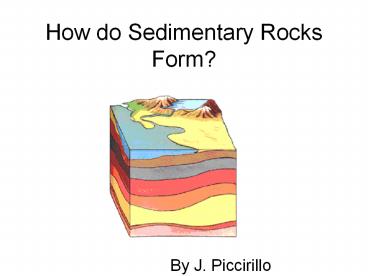How do Sedimentary Rocks Form? - PowerPoint PPT Presentation
Title:
How do Sedimentary Rocks Form?
Description:
How do Sedimentary Rocks Form? By J. Piccirillo For thousands, even millions of years, little pieces of our earth have been eroded--broken down and worn away by wind ... – PowerPoint PPT presentation
Number of Views:261
Avg rating:3.0/5.0
Title: How do Sedimentary Rocks Form?
1
How do Sedimentary Rocks Form?
- By J. Piccirillo
2
- For thousands, even millions of years, little
pieces of our earth have been eroded--broken down
and worn awayby wind and water - (ice included).
3
- These little bits of our earth are washed
downstream by - ( E. )where they
settle to the bottom of the rivers, lakes, and
oceans.
4
- Layer after layer of eroded earth sediments have
been deposited and buried on top of each other.
5
- These layers are pressed down (
) more and more through time, until the
bottom layers slowly turn into rock.
6
- While compacting, these sediments are also glued
- ( ) together by
dissolved minerals oozing from the sediments
7
- Eventually all the weight of Sediment squeezes
all or most of the water out.
8
- Later on through many years of Earth moving
upward or seas retreating or evaporating the
compacted sediment turns into Hard Rock when
exposed above the earths surface.
9
http//www.classzone.com/books/earth_science/terc/
content/investigations/es0602/es0602page02.cfm?cha
pter_noinvestigation
10
TYPES OF SEDIMENTARY ROCKS
Clastic rocks
Chemical Organic rocks
- Conglomerates
- Breccia
- Sandstones
- Siltstones
- Shale/mudstones
Carbonate rocks
Organic rocks
Form basically from CaCO3 (Calcite) both by
chemical leaching and by organic source
(biochemical) eg. Fossil Limestone Dolostone
(MgCO3)
Form due to decomposition of organic remains
under temperature and pressure eg. Coal/Lignite
etc.
Evaporitic rocks
These rocks are formed due to evaporation of
saline water (sea water) eg. Gypsum, Halite
(rock salt)
11
CLASTIC ROCKS
- Formed from broken rock fragments weathered and
eroded by river, glacier, wind and sea waves.
These clastic sediments are found deposited on
floodplains, beaches, in desert and on the sea
floors.
Clastic rocks
solidify
- Clastic rocks are classified on the basis of the
grain size conglomerate, sandstone, shale etc.
12
GRAIN SIZE
Sand 2- 0.062 mm
Clay lt0.0004 mm
Silt 0.062 - 0.0004 mm
Gravel lt 256 - 2 mm
Boulder gt256mm Cobble 64-256 mm Pebble 4-64
mm Granule 2-4mm Fine gravel
13
Non- Clastic or Chemical or Crystalline
EVAPORITIC ROCKS
These rocks are formed within the depositional
basin from chemical substances dissolved in the
seawater or lake water.
Halite
(NaCl)
CaSO4.2H20
14
Economic importance of Evaporites
- SALT other then daily use of salt for cooking,
it is used - For production of Paper,
- Soap
- Detergents
- Antiseptics
- As chemical for dyeing etc.
- GYPSUM is used for plaster and in manufacturing
construction materials.
15
Non- Clastic CARBONATE ROCKS
- Limestone It is a non-clastic rock formed either
chemically or due to precipitation of calcite
(CaCO3) from organisms usually (shell). These
remains will result in formation of a limestone. - Limestones formed by chemical precipitation are
usually fine grained, whereas, in case of organic
limestone the grain size vary depending upon the
type of organism responsible for the formation - -Chalk which is made up of foraminefera is very
fine grained - -Fossiliferous Limestone which medium to coarse
grained, as it is formed out of cementation of
Shells.
16
- used as a building stone and in the manufacture
of lime, carbon dioxide, and cement. - Massive and compact lst. Are competent to
support CE-structure - However, if it occur in huge thickness then it is
not advisable, because of its typical CAVING
character.
17
- Lets look at some sedimentary rocks with your
teacher using the ESRT.
18
Conglomerate(has large and small grains mixed)
19
Conglomerate
20
Sandstone Varieties
21
Fossil Sandstone
22
(from clay) shows some layering
- Shale
23
Limestone - chemical variety..from precipitated
calcite out of seawater.. deposited on the bottom
beds of evaporated seas and lakes and from sea
animal shells
24
Rock Gypsum(looks like cake and flakes)
25
Halite (rock Salt..looks crystally)
26
Fossil Limestone.organic varietyBioclastic
27
Fossil Limestone































